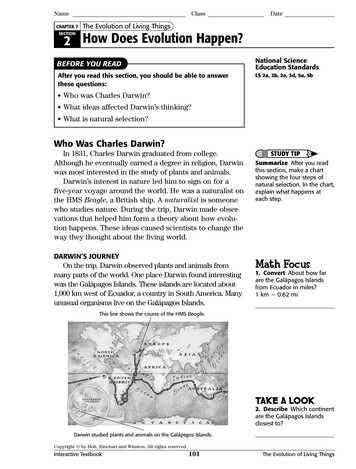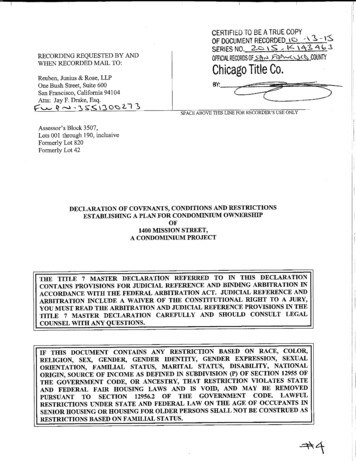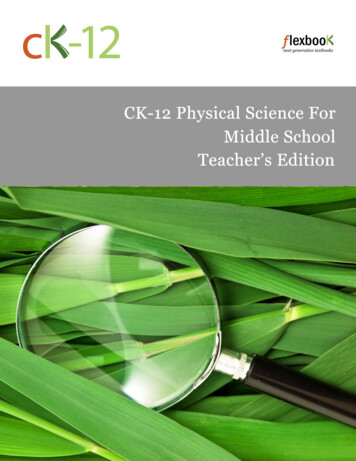
Transcription
NameClassCHAPTER 7DateThe Evolution of Living ThingsSECTION2 How Does Evolution Happen?National ScienceEducation StandardsBEFORE YOU READAfter you read this section, you should be able to answerthese questions:LS 2a, 2b, 2e, 3d, 5a, 5b Who was Charles Darwin? What ideas affected Darwin’s thinking? What is natural selection?Who Was Charles Darwin?In 1831, Charles Darwin graduated from college.Although he eventually earned a degree in religion, Darwinwas most interested in the study of plants and animals.Darwin’s interest in nature led him to sign on for afive-year voyage around the world. He was a naturalist onthe HMS Beagle, a British ship. A naturalist is someonewho studies nature. During the trip, Darwin made observations that helped him form a theory about how evolution happens. These ideas caused scientists to change theway they thought about the living world.DARWIN’S JOURNEYOn the trip, Darwin observed plants and animals frommany parts of the world. One place Darwin found interestingwas the Galápagos Islands. These islands are located about1,000 km west of Ecuador, a country in South America. Manyunusual organisms live on the Galápagos Islands.STUDY TIPSummarize After you readthis section, make a chartshowing the four steps ofnatural selection. In the chart,explain what happens ateach step.Math Focus1. Convert About how farare the Galápagos Islandsfrom Ecuador in miles?1 km 0.62 miThis line shows the course of the HMS Beagle.TAKE A LOOK2. Describe Which continentare the Galápagos Islandsclosest to?Darwin studied plants and animals on the Galápagos Islands.Copyright by Holt, Rinehart and Winston. All rights reserved.Interactive Textbook101The Evolution of Living Things
NameSECTION 2ClassDateHow Does Evolution Happen? continuedDARWIN’S FINCHESREADING CHECK3. Describe What didDarwin observe about thefinches on the GalápagosIslands?Darwin observed that the animals and plants onthe Galápagos Islands were similar to those in Ecuador.However, they were not identical. For example, Darwinclosely observed birds called finches. The finches on theGalápagos Islands were slightly different from the finchesin Ecuador. In addition, the finches on each island in theGalápagos differed from the finches on the other islands.Darwin hypothesized that the island finches weredescendents of South American finches. He thought thefirst finches on the islands were blown there from SouthAmerica by a storm. He suggested that over many generations, the finch populations evolved adaptations thathelped them survive in the different island environments.For example, the beaks of different finch species areadapted to the kind of food the species eat.The large ground finch has a wide,strong beak. It can easily crack openlarge, hard seeds. Its beak workslike a nutcracker.The cactus finch has a tough beak. Ituses its beak to eat cactus parts andinsects. Its beak works like a pair ofneedle-nose pliers.Critical Thinking4. Infer What can you guessabout the environment inwhich the cactus finch livesbased on the information inthe figure? Explain your answer.The warbler finch has a small,narrow beak. It can catch smallinsects with its beak. Its beakworks like a pair of tweezers.Copyright by Holt, Rinehart and Winston. All rights reserved.Interactive Textbook102The Evolution of Living Things
NameSECTION 2ClassDateHow Does Evolution Happen? continuedHow Did Darwin Develop the Theory ofEvolution by Natural Selection?After Darwin returned to England, he spent many yearsthinking about his experiences on the trip. In 1859, Darwinpublished a famous book called On the Origin of Species byMeans of Natural Selection. In his book, Darwin proposedthe theory that evolution happens by natural selection.Natural selection happens when organisms thatare well adapted to their environment survive, but lesswell-adapted organisms do not. When the better-adaptedorganisms reproduce, they pass their useful traits on totheir offspring. Over time, more members of the population have these traits. Darwin combined ideas aboutbreeding, population, and Earth’s history to come up witha theory to explain his observations.READING CHECK5. Define What is naturalselection?IDEAS ABOUT BREEDINGIn Darwin’s time, farmers and breeders had producedmany kinds of farm animals and plants. They learned thatif they bred plants or animals that had a desirable trait,some of the offspring might have the trait. A trait is aform of an inherited characteristic. The practice in whichhumans select plants or animals for breeding based ondesired traits is called selective breeding.Selective breeding showed Darwin that the traits oforganisms can change and that certain traits can spreadthrough populations. For example, most pets, such as thedogs below, have been bred for a variety of desired traits.Over the past 12,000 years, people have selectively breddogs to produce more than 150 breeds.READING CHECK6. Explain How did ideasabout selective breedingaffect Darwin’s thinkingabout evolution?People have selectively bred dogs for different traits. Today, there areover 150 dog breeds.Copyright by Holt, Rinehart and Winston. All rights reserved.Interactive Textbook103The Evolution of Living Things
NameSECTION 2ClassDateHow Does Evolution Happen? continuedIDEAS ABOUT POPULATIONREADING CHECK7. Identify According toThomas Malthus, what aretwo things that can limit thesize of human populations?During Darwin’s time, a scientist named ThomasMalthus was studying human populations. He observedthat there were more babies being born than there werepeople dying. He thought that the human populationcould grow more rapidly than food supplies could grow.This would result in a worldwide food shortage. Malthusalso pointed out that the size of human populations islimited by problems such as starvation and disease.Darwin realized that Malthus’s ideas can apply to allspecies, not just humans. He knew that any species canproduce many offspring. He also knew starvation, disease, competition, and predation limited the populationsof all species. Only a limited number of individuals livelong enough to reproduce.Darwin reasoned that the survivors had traits thathelped them survive in their environment. He alsothought that the survivors would pass on some of theirtraits to their offspring.IDEAS ABOUT EARTH’S HISTORYREADING CHECK8. Explain How did CharlesLyell’s book change howscientists thought aboutEarth’s history?New information about Earth’s history also affectedDarwin’s ideas about evolution. During Darwin’s time,most geologists thought that Earth was very young.But important books, such as Principles of Geologyby Charles Lyell, were changing ideas about the Earth.Lyell’s book gave evidence that Earth is much older thananyone once thought.Darwin thought that evolution happens slowly. Darwinreasoned that if Earth was very old, there would beenough time for organisms to change slowly.IdeaHow it contributed to Darwin’s theorySelective breedinghelped Darwin realize that not all ofan organism’s offspring will survive toreproducehelped Darwin realize that slow changescan produce large differences over a longperiod of timeTAKE A LOOK9. Describe Fill in the blankspaces in the table.Copyright by Holt, Rinehart and Winston. All rights reserved.Interactive Textbook104The Evolution of Living Things
NameSECTION 2ClassDateHow Does Evolution Happen? continuedHOW NATURAL SELECTION WORKSNatural selection has four steps: overproduction,inherited variation, struggle to survive, and successfulreproduction.Say It1Overproduction A tarantula’s egg saccan hold 500 to 1,000 eggs. Some ofthe eggs will survive and develop intoadult spiders. Some will not.2Inherited Variation Everyindividual has its own combinationof traits. Each tarantula is similar,but not identical, to its parents.Give Examples The figureshows one example of howthe four steps of naturalselection can work. In agroup, talk about three ormore other examples of hownatural selection can affectpopulations.TAKE A LOOK3Struggle to Survive Some tarantulas may have traits that make itmore likely that they will survive.For example, a tarantula may bebetter able to fight off predators,such as this wasp.4Successful Reproduction Thetarantulas that are best adaptedto their environment are likelyto survive and reproduce. Theiroffspring may inherit the traits thathelp them to survive.10. Identify Why are sometarantulas more likely tosurvive than others?GENETICS AND EVOLUTIONDarwin knew that organisms inherit traits, but nothow they inherit traits. He also knew that there is greatvariation among organisms, but not how that variationhappens. Today, scientists know that genes determinethe traits of an organism. These genes are exchanged andpassed on from parent to offspring.Copyright by Holt, Rinehart and Winston. All rights reserved.Interactive Textbook105The Evolution of Living Things
NameClassSection 2 ReviewDateNSESLS 2a, 2b, 2e, 3d, 5a, 5bSECTION VOCABULARYnatural selection the process by which individualsthat are better adapted to their environmentsurvive and reproduce more successfully thanless well adapted individuals do; a theory toexplain the mechanism of evolutionselective breeding the human practice ofbreeding animals or plants that have certaindesired traitstrait a genetically determined characteristic1. Explain How did the ideas in Charles Lyell’s book affect Darwin’s thinkingabout evolution?2. Identify In what way are the different finch species of the Galápagos Islandsadapted to the different environments on the islands?3. Compare How is natural selection different from selective breeding?4. Describe How did Darwin apply Malthus’s ideas about human populations to thetheory of evolution by natural selection?5. List What are the four steps of natural selection?Copyright by Holt, Rinehart and Winston. All rights reserved.Interactive Textbook106The Evolution of Living Things
Life Science Answer Key continued9. DNA is a double strand, and RNA is a single10.11.12.13.14.15.9. Modern whales are mammals, not fish.10. Modern whales have no back legs, and theystrand.DNA makes a copy of itself called messenger RNA. mRNA has the same order of basesas one of the DNA strands. mRNA leavesthe nucleus and goes to the ribosome in thecytoplasm, where proteins are made.tRNA delivers amino acids from thecytoplasm to the ribosome.a change in the nucleotide-base sequence ofDNAThe other strand also changes.substitutionchanging individual genes within organismscannot live on land. Both have front limbsand are or were mammals.11. Fossils or bones of each species share sometraits with fossils of earlier species.12. hippopotamuses13. camels and llamasReview1. Similar bones are found in the arms ofhumans and the wings of bats. The similarities in forelimb bones suggest that humansand bats had a common ancestor.2. From top to bottom: orangutans, chimpanzees, humans, gorillas3. Species A is probably most closely related tospecies B, because their DNA is most similar.Review1. Possible answers: chromosomes, chromatin,2.3.4.5.chromatidseightDNA, mRNA, ribosome, proteinGenes determine traits. DNA mutations cancause changes in proteins that make up thegenes. If the genes change, the traits change.The new trait could be inherited if thechange is on a sperm or egg cell.evidence in criminal cases, determiningwhether two people are relatedSECTION 2 HOW DOES EVOLUTIONHAPPEN?1. about 600 mi2. South America3. They were similar to, but not exactly like, the4.Chapter 7 The Evolution ofLiving Things5.SECTION 1 CHANGE OVER TIME1. Its bright colors warn predators that it is2.3.4.5.6.7.8.6.poisonous, so it is less likely to be eaten.Possible answer: hiding when predators arenearbythe process in which populations changeover timeSome fossils are the actual remains oforganisms. Others are signs that an organism existed.Either fossil is acceptable as an answer. Thetrilobite is similar to modern crustaceans.The fern is similar to modern ferns.Fossils from different organisms are foundin rocks of different ages.Similar bones in each image should be thesame color, with a different color for eachtype of bone.These chemicals are not preserved in fossils.7.8.9.10.finches in Ecuador. The finches on each islandwere different from those on other islands.The cactus finch is adapted to eating cacti.Therefore, it probably lives in a dry, desert-likeenvironment where cacti can grow.the process in which well-adapted organismssurvive and pass on their traits, but less welladapted organisms do notThey helped Darwin realize that the traitsof organisms can change and that traits canspread through populations.starvation and diseaseIt gave evidence that Earth is much older thanscientists had previously thought.Selective breeding: helped Darwin realize thattraits of organisms can change with time andthat traits can spread through populations;Malthus’s ideas on population growth:helped Darwin realize that not all of anorganism’s offspring will survive to reproduce;Earth is very old: helped Darwin realize thatslow changes can produce large differencesover a long period of timeThey have traits that help them avoid dying.Copyright by Holt, Rinehart and Winston. All rights reserved.Interactive Textbook Answer Key7Life Science
Life Science Answer Key continuedReview1. Lyell’s book gave evidence that Earth is very2.3.4.5.2. No, because only the shape of the shell is pre3.old. Because Earth is very old, there has beenenough time for organisms to change slowlyover time.The finches have differently shaped beaksbased on the type of food they primarily eat.During natural selection, certain individualssurvive because they have traits that give thema survival advantage over other individuals.During selective breeding, people breed individuals for traits that people find appealing or useful, even if the traits have no particular survivaladvantage.Darwin realized that Malthus’s ideas apply toall species. Most individuals produce more offspring than can survive. The size of a population is limited by the availability of resources,starvation, disease, and predation.overproduction, inherited variation, struggle tosurvive, successful reproduction4.5.6.7.8.9.10.served. The “inside” of the cast is just sediment.determining the age of a rock or fossilcompared with other rocks or fossilsAbsolute dating finds the age of an object inyears, but relative dating finds its age comparedwith other objects. Absolute dating is moreprecise than relative dating.It decreases.It would be more difficult for them to shareinformation about Earth’s history, because theirtime scales would have different divisions.Triassic, Jurassic, CretaceousIf the species cannot adapt to coolertemperatures, all of its members will die.The part of Pangaea that looks like Africashould be circled.They are carried along as the plates move.Review1. Possible answer: The geologic time scale isa calendar that geologists use to study theEarth’s history.2. impacts, volcanic eruptions, changing oceancurrents3. Fossil C is probably the oldest, because it isthe closest to the bottom.4. An organism dies and is buried in sediment.The body of the organism rots away, leavingan impression in the sediment. Then, differentsediment fills the impression. This sedimentthen hardens into a fossil called a cast.SECTION 3 NATURAL SELECTION IN ACTION1.2.3.4.5.People hunt tusked elephants.something that kills insectsThey would all die.It will probably decrease.Speciation happens when new species formbecause of evolution.6. Different environmental factors may affect thepopulations, leading to different adaptations.7. South AmericaSECTION 2 ERAS OF THE GEOLOGIC TIMESCALEReview1. separation, adaptation, division1. about 4.1 billion years2. Energy from radiation or storms caused2. salty water, changing water level, high risk ofbeing crushed between or against rocks3. mountains, canyons, lakes4. Insects have many offspring, and they have ashort generation time.5. Organism B will probably be able to adaptmore quickly to environmental changesbecause it has a short generation time andproduces many offspring per generation.simple chemicals to react.3. a process in which a living thing converts4.5.Chapter 8 The History ofLife on Earth6.7.8.SECTION 1 EVIDENCE OF THE PAST1. a scientist who studies organisms that lived9.in the pastsunlight, water, and carbon dioxide intofood and oxygenCyanobacteria released oxygen duringphotosynthesis.Cambrian, Ordovician, Silurian, Devonian,Carboniferous, Permianin the oceanscrawling insectsMany species of reptiles evolved during theMesozoic.Scientists think that birds may have evolvedfrom some dinosaurs.Copyright by Holt, Rinehart and Winston. All rights reserved.Interactive Textbook Answer Key8Life Science
IDEAS ABOUT EARTH’S HISTORY New information about Earth’s history also affected Darwin’s ideas about evolution. During Darwin’s time, most geologists thought that Earth was very yo











